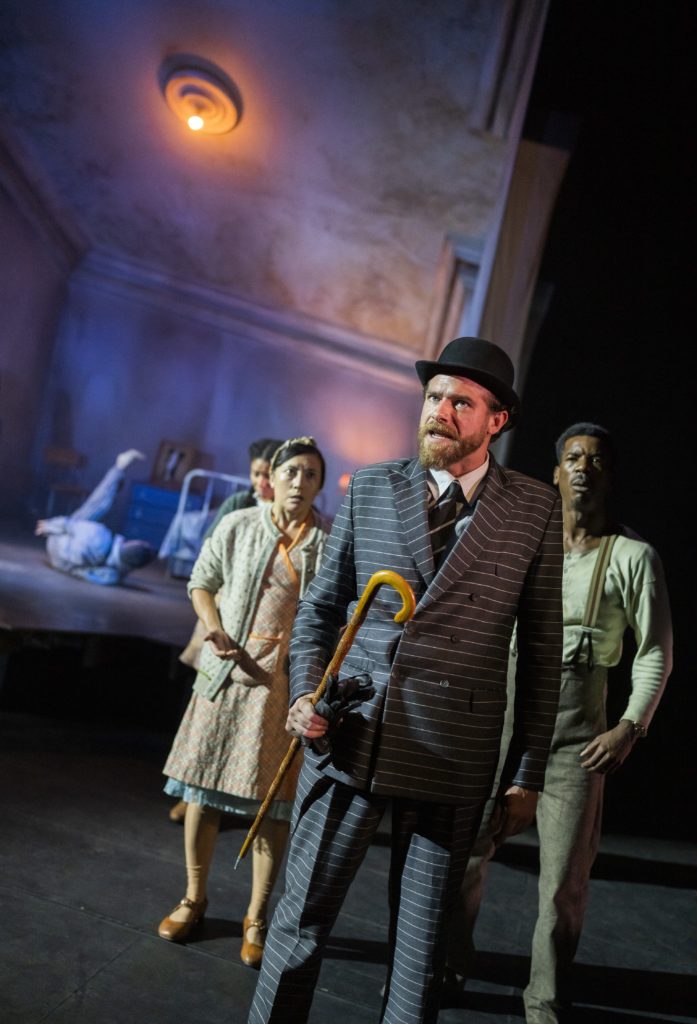
SHOULD Frantic Assembly transfer Franz Kafka’s absurdist novella Metamorphosis from page to stage?
Artistic director Scott Graham’s initial reaction was No, but its themes of the crushing burden of debt, subsequent dysfunctional family relations, monotonous work for low pay, fear of isolation and an unhealthy obsession with identity made it as much a story for our time as of 1912.
That surely made it ripe for a company noted for the heft of its emotional truths? Then add wave upon wave of Kakfa surrealism to bring out Frantic Assembly’s other trademark: movement. The physicality to complement all that mental turbulence.
Now Graham needed a writer, one to work in tandem with him in creating a 21st century reinvention of Metamorphosis, its world of social immobility, dashed expectations, repetitive restraints, impoverishment and exploitation, but still with the look of the early 20th century (courtesy of Jon Bauser’s design and Becky Gunstone’s period costumes).
Lemn Sissay OBE, esteemed poet, broadcaster and speaker, was his pick but again the first inclination was No. However, he too felt the tug of Kafka’s torrid tale, seeing within its desperation, a chance to depict Gregor’s transformation as the embodiment of the woes of modern capitalism.
Two forces are at play in Graham’s production, movement and language, not always in union, however.

Movement first, the more satisfying, more successful component. Bauser’s set, with its sloping ceiling, cut-off-at-the-knees floor, silken walls and sparse furnishings, conspires with Ian William Galloway’s video designs, Helen Skiera’s soundscapes, Stefan Janik’s unnerving compositions and Simisola Majekodunmi’s all-important lighting to be disorientating for audience and Brazilian-English actor and movement practitioner Felipe Pacheco’s Gregor Samsa alike.
The Samsa house, or more precisely, Gregor’s room within it, is constantly, subtly, deceptively, on the move, as if a magician with dexterous sleight of hand is at work. The physicality of the stage in motion is as imvital here as human movement. Or insect movement, in the case of poor Gregor.
As a sidenote, the sense of a house on the move, of tectonic shifts, is more effectively portrayed than in Les Enfants Terribles’ Theatre Royal visit last month with The House With Chicken Legs.
Your reviewer recalls lighting last being used so strikingly, as a character in itself, in the Lyric Hammersmith’s Ghost Stories at the Grand Opera House in pre-Covid March 2020.
Here, in one extraordinary scene, as Pacheco’s Gregor swings on the wiring from the detached ceiling light, the light in his hand keeps switching on and off. Off, back on, and he has moved again. Again and again.
This is movement and meaning in perfect symmetry, with Pacheco as spry as a Buster Keaton or Harold Lloyd, but not comical, more like Jeff Goldblum in The Fly.

By comparison with the visual, the verbal is uneven, sometimes playful, other times earnest or abstract; sometimes snappy, other times, weighty and wordy in monologues for Troy Glasgow’s wastrel, hypocritical, hyper-critical Mr Samsa and his compliant wife (Louise Mai Newberry).
Shards of humour pierce the surrealist surface, but the overall tone is disquieting, discomfiting. For all the poetic verve and political vigour, momentum is lost, rather than gained, post-interval, when more interaction would have been beneficial (like in the scenes with Joe Layton’s Chief Clerk), rather than the fragmented, episodic structure of lone voices.
In the best decision, Gregor’s transformation to an insect is depicted not as an overnight sensation, but as a gradual consequence of his debilitating, repetitive daily routine as a clothing salesman, with all the pressures of being the sole breadwinner, That works wonderfully well across the first half, captured in Pacheco’s Groundhog Day grind, climaxing with Gregor encased in four chairs, looking not unlike a beetle for the only time.
Likewise, the metamorphosis of Gregor’s young sister, Hannah Sinclair Robinson’s Grete, takes on more prominence in Sissay’s account, wherein she hates the discipline of having to play the violin yet craves the spotlight. How very 21st century! Her face-pulling solo scene by the mirror is a stand-out, one that finds Sissay, Graham and Sinclair Robinson conveying character as one.
That scene is typical of a production with moments and ideas of theatrical brilliance rather than creative cohesion. Last autumn’s bar-room Othello was superior, but Frantic Assembly are always worth seeing, for those exciting highs, the visual fire storms, the brutal, yet beautiful physicality.
Performances: 7.30pm tonight and tomorrow; 2.30pm and 7.30pm, Saturday. Box office: 01904 623568 or yorktheatreroyal.co.uk.
